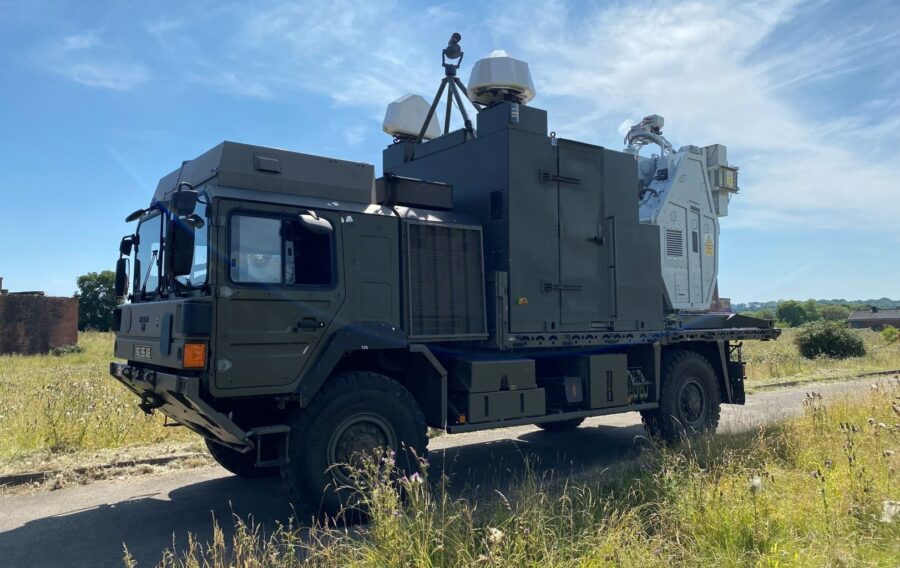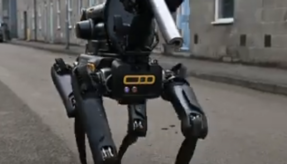
Game-changing Radio Frequency Directed Energy Weapon (RFDEW) neutralises drone swarms for just 10p per shot, supporting over 135 skilled UK jobs.
British soldiers have conducted a successful trial of the Radio Frequency Directed Energy Weapon (RFDEW), a pioneering system designed to neutralise drones and other threats using high-frequency radio waves. Capable of engaging targets up to 1km away at an operating cost of just 10p per shot, this breakthrough technology provides a cost-effective and precise alternative to traditional missile-based air defence systems.
The RFDEW development system, spearheaded by Thales UK in collaboration with QinetiQ, Teledyne e2v, and Horiba Mira, supports more than 135 skilled jobs across the UK and reflects the Ministry of Defence’s commitment to delivering cutting-edge capabilities as part of its Plan for Change.
How RFDEW Works
Unlike Laser Directed Energy Weapons (such as DragonFire), which use beams of light, RFDEWs rely on radio waves to disrupt or damage the electronic components of drones and other devices, rendering them inoperable. This makes it highly versatile, with applications across land, sea, and air domains.
Its advanced automation allows the system to be operated by a single soldier and integrated onto military vehicles for mobility, enhancing the UK Armed Forces’ agility and response capabilities.
Successful Trials in Wales
The Royal Artillery Trials and Development Unit and 7 Air Defence Group conducted live firing trials at a range in West Wales, marking the first operational use of RFDEW by British forces. These trials successfully targeted and neutralised Uncrewed Aerial Systems (UAS), demonstrating the system’s ability to counter emerging aerial threats.
The trials were part of an extensive user experimentation programme designed to evaluate the weapon’s performance across varied environments, threat types, and scenarios.
Collaborative Development
The RFDEW project was delivered by Team HERSA, a partnership between the UK MOD’s Defence Equipment & Support (DE&S) and Defence Science and Technology Laboratory (Dstl).
Matt Cork, Dstl Programme Lead, said: “Getting this technology into the hands of our service personnel is hugely rewarding. Collaborative work with DE&S and industry has driven the rapid evolution of radio frequency technology.”
Industry and Government Reaction
Minister for Defence Procurement and Industry, Maria Eagle MP, said: “The successful trial of this sovereign weapon system is another step forward for the UK’s defence capabilities. It showcases how collaboration between defence experts and industry can deliver cutting-edge equipment to our Armed Forces and maintain our advantage against emerging threats.”
Nigel MacVean, Managing Director of Thales IAS, added: “I am thrilled with the successful RFDEW firing trials. Thales has been at the forefront of this pioneering technology for over 40 years, and these trials pave the way for a strong future in this field.”
Looking Ahead
With continued trials planned, Team HERSA is working to refine RFDEW requirements, operational doctrine, and technology. This programme signals a significant leap forward in enhancing the UK Armed Forces’ capabilities to counter aerial threats, ensuring precision, cost-efficiency, and operational superiority in future engagements.
This milestone reinforces the UK’s position as a leader in directed energy weapon development and underscores the Government’s commitment to delivering innovative defence solutions that secure the nation’s safety and prosperity.
If you would like to join our community and read more articles like this then please click here
DE&S drones Dstl Horiba Mira QinetiQ RFDEW Teledyne e2v Thales








